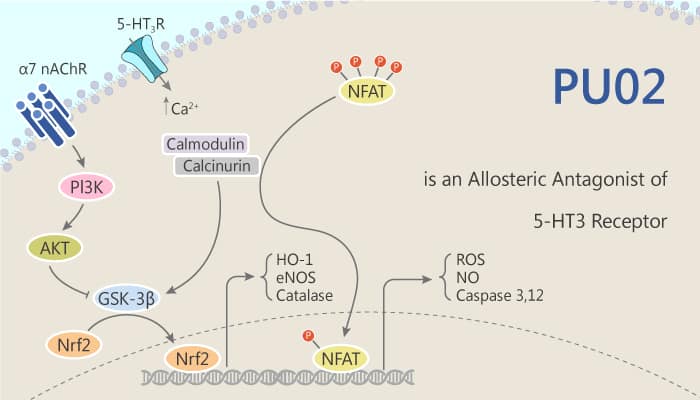Cancer is a usual disease and a leading cause of death in the world. Therefore, developing new agents specifically targeting cancer cells has achieved more and more researches. As it is widely believed that cancer can be treated by inducing tumor cells to undergo senescence or apoptosis, screening for drug-like small-molecule compounds that can inhibit cancer growth.
Apoptosis is a normal cell mechanism in development and homeostasis. Two cell signaling transduction pathways have been demonstrated that are involved in apoptosis: the mitochondrial pathway and death receptor pathway. In this study, scientists screened a chemical library screen in order to find new agents that can selectively inhibit the viability of cancer cells. Among the compounds, a novel compound PU02 (NMMP) was identified. The authors evaluated the antitumor activities of NMMP and explored the mechanisms by which this compound exerts its effects.

PU02, a derivative of 6-MP, is an allosteric antagonist of the 5-HT3 receptor.
PU02 (NMMP) (0-200 μM) leads to a steady decrease in cell viability of HepG2 cells, with an IC<sub>50</sub> of 48.585 μM. PU02 (NMMP) shows less toxicity on L02 cells than did 6-MP after 48 h of treatment. In addition, PU02 (NMMP) at 6.25 or 25 μM exhibits inhibitory effects on the viability of the tested cell lines, including SMMC-7721, MDA-MB-231, RKO, and HCT-8 cells. Especially, PU02 (NMMP) induces cell cycle arrest at the G2/M phase. PU02 (NMMP) downregulated the expression of cyclin B1/D1 and CDK4 in a time-dependent manner in HepG2 cells but has no effect on the expression of cyclin E.
Moreover, PU02 (NMMP)-treated cells exhibited a significant increase in caspase-3 cleavage, suggesting enhanced apoptotic activity. Lastly, PU02 exhibits IC<sub>50</sub> values of 0.36 and 0.73 μM in HEK293 cells transfected with human 5-HT3A and 5-HT3AB receptors respectively.
PU02 has the potential for cancer therapy.
Xiao-Guang Yang, et al. 6-[(1-naphthylmethyl)sulfanyl]-9H-purine induces G2/M phase arrest and apoptosis in human hepatocellular carcinoma HepG2 cells. Eur J Pharmacol. 2012 Nov 15;695(1-3):27-33.